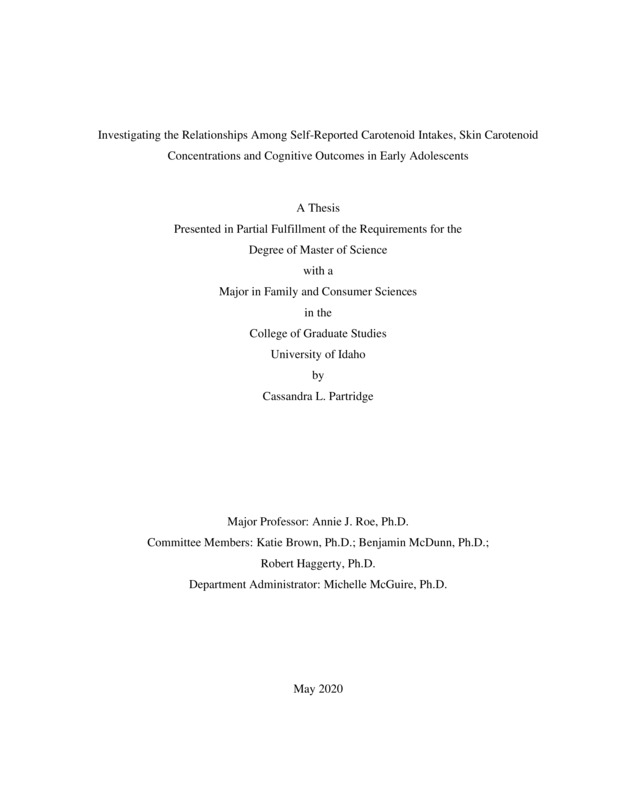Investigating the Relationships Among Self-Reported Carotenoid Intakes, Skin Carotenoid Concentrations and Cognitive Outcomes in Early Adolescents
Partridge, Cassandra. (2020-05). Investigating the Relationships Among Self-Reported Carotenoid Intakes, Skin Carotenoid Concentrations and Cognitive Outcomes in Early Adolescents. Theses and Dissertations Collection, University of Idaho Library Digital Collections. https://www.lib.uidaho.edu/digital/etd/items/partridge_idaho_0089n_11804.html
- Title:
- Investigating the Relationships Among Self-Reported Carotenoid Intakes, Skin Carotenoid Concentrations and Cognitive Outcomes in Early Adolescents
- Author:
- Partridge, Cassandra
- Date:
- 2020-05
- Keywords:
- Carotenoids Cognition
- Program:
- Family and Consumer Sciences
- Subject Category:
- Nutrition
- Abstract:
-
Lutein and zeaxanthin are two carotenoids, known as the xanthophylls, which have recently garnered attention for their potential role in cognition. Within the brain, the xanthophylls are believed to be protective via their action as antioxidants. Previous research has indicated possible correlations between serum and macular carotenoid concentrations and cognitive outcomes, but results are generally mixed, particularly when referring to specific aspects of cognition. Measurement of carotenoids via resonance Raman spectroscopy of the skin is reliable, non-invasive and requires minimal training, but there is limited research examining the direct relationship between skin carotenoid concentrations and measures of cognition. Additional insight is needed on the nature of these associations in younger populations.
The purpose of this research was to investigate the relationships among self-reported carotenoid intake, skin carotenoid concentrations and cognitive outcomes in early adolescents. Thirty adolescents aged 11-14 years participated in the cross-sectional study. Dietary intake of lutein and zeaxanthin, lycopene, alpha and beta-carotene, cryptoxanthin, total carotenoids, and total fruits and vegetables were assessed from three days of 24-hour dietary recall data collected and analyzed using the Automated Self-Administered 24-hour (ASA24) Dietary Assessment Tool, developed by the National Cancer Institute. Skin carotenoid concentrations were measured by resonance Raman spectroscopy. Assessments from the NIH Toolbox for Assessment of Neurological and Behavioral Function were administered to determine scores of executive function, episodic memory, working memory, attention, processing speed, and fluid cognition, all adjusted for age, gender, race, ethnicity, and parent education. Data analysis was conducted using SAS software and a significance value of p≤0.05. Pearson correlations were used to evaluate the relationship between variables with a normal distribution and Spearman correlations were used between variables not exhibiting characteristics of normality. No significant relationships were found between skin carotenoid concentrations and intakes of carotenoids, including lutein and zeaxanthin. A significant positive association was found between skin carotenoid concentrations and scores of working memory (R2 = 0.43, p=0.02). A significant inverse relationship was noted between intakes of lutein and zeaxanthin and scores of working memory (R2 = -0.43, p=0.02) and significant positive correlations were found between scores of episodic memory and intakes of cryptoxanthin (R2 = 0.41, p=0.02), lycopene (R2 = 0.40, p=0.03), total carotenoids (R2 = 0.39, p=0.03), and total fruit and vegetable intake (R2 = 0.38, p=0.04). Overall, skin carotenoid concentrations were positively associated with scores of working memory. Dietary intake of lutein and zeaxanthin was negatively associated with working memory scores and intakes of cryptoxanthin, lycopene, and total carotenoids were positively associated with episodic memory scores in adolescents aged 11-14 years. Dietary intake of specific carotenoids may have varied associations with specific domains of cognition. Larger sample sizes are needed to comprehensively evaluate these relationships in adolescent populations.
- Description:
- masters, M.S., Family and Consumer Sciences -- University of Idaho - College of Graduate Studies, 2020-05
- Major Professor:
- Roe, Annie J
- Committee:
- Brown, Katie; McDunn, Benjamin; Haggerty, Robert
- Defense Date:
- 2020-05
- Identifier:
- Partridge_idaho_0089N_11804
- Type:
- Text
- Format Original:
- Format:
- application/pdf
- Rights:
- In Copyright - Educational Use Permitted. For more information, please contact University of Idaho Library Special Collections and Archives Department at libspec@uidaho.edu.
- Standardized Rights:
- http://rightsstatements.org/vocab/InC-EDU/1.0/

